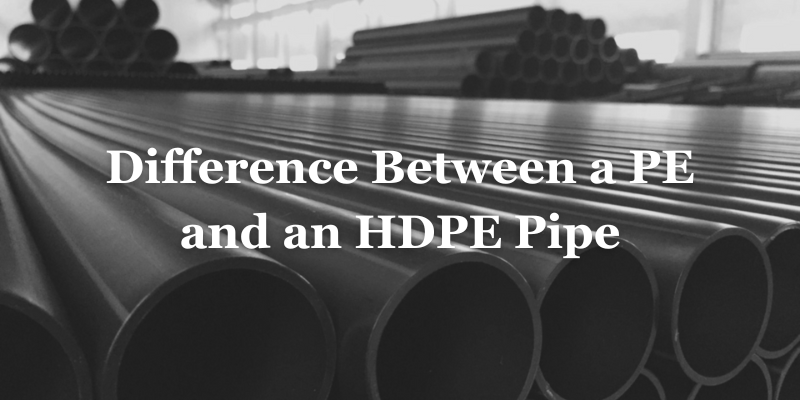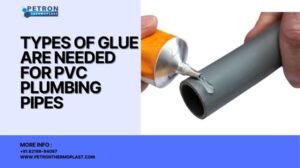Introduction
Difference Between a PE and an HDPE Pipe. When we delve into the world of plumbing and piping systems, one thing becomes abundantly clear – the choice of materials is paramount. It’s what ensures the efficiency, durability, and overall safety of your infrastructure. In this complex realm, two terms often emerge: PE (Polyethylene) and HDPE (High-Density Polyethylene) pipes. At first glance, these two might seem like mere alphabet soup, but they possess unique characteristics that render them suited for distinct applications. So, let’s take a deep dive into the intricacies that set these pipes apart.
Difference Between a PE and an HDPE Pipe
Here are the difference between a PE and an HDPE pipe given below:
Polyethylene (PE) Pipes
Polyethylene (PE) is a versatile thermoplastic polymer that has found its way into countless industrial applications over the years. In the realm of piping, PE pipes have carved out a niche for themselves, lauded for their flexibility, lightweight nature, and resistance to corrosion. These pipes are further subdivided based on their density, with HDPE being a prominent category. So, let’s dissect the world of PE pipes, exploring their traits and typical applications:

1. Material Composition
At the heart of PE pipes lie ethylene monomers, intricately chemically bonded to create long chains of polyethylene molecules. This molecular dance grants PE pipes their hallmark flexibility, making them malleable to assume various shapes and sizes.
2. Density
The world of PE pipes is divided into different density classifications – there’s Low-Density Polyethylene (LDPE), Medium-Density Polyethylene (MDPE), and our star today, High-Density Polyethylene (HDPE). The density factor plays a pivotal role, influencing attributes such as strength, rigidity, and resistance to the elements.
3. Flexibility
Flexibility is the name of the game for PE pipes. They are quite the contortionists, capable of withstanding bending and stretching without compromising their structural integrity. This inherent quality makes them the go-to choice for situations where pipes must navigate tricky bends or follow unconventional paths.
4. Corrosion Resistance
PE pipes have a distinct knack for thumbing their noses at corrosion. Whether it’s water, other fluids, or even the elements themselves, they don’t corrode, rust, or degrade. Their resilience shines when they encounter moisture, chemicals, or the unpredictable world of soil conditions.
5. Applications of PE Pipes
PE pipes don multiple hats in various applications, such as:
- Water Supply: The corrosion resistance and durability of PE pipes make them a trusted choice in municipal and residential water supply systems.
- Natural Gas Distribution: When it comes to distributing natural gas, PE pipes step up to the plate due to their robust resistance to chemical degradation.
- Irrigation Systems: Agriculture relies on PE pipes for their flexibility and long life span, catering to the needs of irrigation systems.
- Telecommunication Conduits: In the realm of telecommunications, PE pipes serve as protective housing for cables, ensuring the seamless flow of information.
- Mining: The mining industry employs PE pipes for the arduous task of transporting slurries and other materials deep underground.
Now that we’ve unraveled the world of PE pipes, let’s venture into the high-density realm of HDPE pipes.
6. PE Pipe Installation Procedure
Installing polyethylene (PE) pipe involves several important steps to ensure a reliable and leak-free plumbing or piping system. PE pipe is commonly used for water supply, gas distribution, and other fluid transport applications. Here’s a general procedure for installing PE pipe:
1. Planning and Design:
- Determine the pipe size and type suitable for your application based on the required flow rate and pressure.
- Plan the layout of the piping system, including the location of fittings, valves, and any required support structures.
- Check local codes and regulations to ensure compliance with installation requirements.
2. Gather Materials and Tools:
- Acquire the necessary PE pipes, fittings, valves, and any additional components.
- Gather tools such as a pipe cutter, chamfering tool, fusion machine (if required), wrenches, and appropriate safety equipment.
3. Site Preparation:
- Clear the work area of any obstructions and ensure a stable and level foundation for the pipeline.
- Identify and mark the locations where the pipe will be installed.
4. Pipe Handling:
- Handle the PE pipe carefully to avoid damage. Protect it from direct sunlight and extreme temperatures.
- Inspect the pipe for any visible defects or damage before installation.
5. Pipe Cutting:
- Measure and mark the pipe at the desired length.
- Use a pipe cutter or a suitable cutting tool to make a clean, perpendicular cut.
6. Pipe Preparation:
- Chamfer the pipe ends using a chamfering tool to remove any burrs and ensure a smooth surface for joining.
7. Jointing Methods:
- PE pipes can be joined using various methods, including butt fusion, electrofusion, mechanical fittings, and compression fittings. The choice of method depends on the pipe size and application.
- Follow the manufacturer’s guidelines and recommendations for the specific jointing method being used.
8. Fusion Welding (for Butt Fusion and Electrofusion):
- Ensure the fusion machine is in good working condition and set to the correct fusion parameters.
- Clean and prepare the pipe ends and fittings as per the manufacturer’s instructions.
- Heat the pipe ends and fittings to the specified temperature.
- Join the pipe and fitting together and allow them to cool and fuse together.
9. Mechanical and Compression Fittings:
- Follow the manufacturer’s instructions for assembling and tightening mechanical or compression fittings.
- Use the appropriate torque settings to ensure a secure connection.
10. Pressure Testing:
Perform pressure testing to verify the integrity of the installed PE pipe system. Ensure that there are no leaks. – Conduct a hydrostatic test or a pneumatic test according to local codes and project specifications.
11. Backfilling and Covering:
Once the installation passes the pressure test, carefully backfill the trench to cover the PE pipe. Use suitable backfill material and compact it properly to prevent settling. – Ensure proper support and bedding to avoid damage to the pipe.
12. Final Inspection and Documentation:
Inspect the entire installation for any visible defects, leaks, or issues. – Document the installation details, including as-built drawings and test results.
13. Restoration:
Restore the site to its original condition, including any landscaping or surface repairs.
14. System Startup and Commissioning:
If applicable, commission the system and test its functionality under actual operating conditions.
15. Maintenance and Monitoring:
Establish a maintenance schedule to regularly inspect and maintain the PE pipe system to ensure its long-term reliability.
High-Density Polyethylene (HDPE) Pipes
High-Density Polyethylene (HDPE) pipes are close kin to PE pipes, sharing the same family tree. However, they boast distinctive qualities that set them apart as the shining stars of the show. HDPE pipes have earned their stripes for their remarkable strength, unyielding resistance to impacts, and versatility spanning across a multitude of applications. So, let’s shine a spotlight on what makes HDPE pipes tick:
1. Molecular Structure
At the heart of HDPE pipes lies a densely packed molecular structure, distinct from other PE pipe variants. This unique arrangement is what earns them the coveted “high-density” tag. It’s this very molecular architecture that lends them their heightened strength and longevity.
2. Strength and Rigidity
HDPE pipes step onto the scene with an impressive air of strength and rigidity. They can shoulder higher pressure levels without breaking a sweat and are notably less susceptible to deformation under duress.
3. Impact Resistance
One of the standout features of HDPE pipes is their unwavering ability to absorb and deflect impacts. They laugh in the face of heavy loads, making them the preferred choice when pipes are subjected to external forces that might crumble lesser materials.
4. Chemical Resistance
HDPE pipes flaunt an almost superhero-like resistance to an array of chemicals. Acids, alkalis, aggressive substances – these pipes stand their ground against them all. This innate quality renders them ideal for the task of transporting an eclectic mix of fluids.
5. Applications of HDPE Pipes
HDPE pipes wear many hats and find themselves in a variety of applications, including:
- Water and Wastewater Systems: Their durability and resistance to corrosion make HDPE pipes a staple in water distribution and sewage systems.
- Mining: The unforgiving world of mining often calls upon HDPE pipes to transport abrasive slurries and materials through harsh conditions.
- Gas Distribution: When it comes to distributing natural gas, HDPE pipes are the go-to choice, thanks to their sheer strength and chemical resilience.
- Industrial Processes: Their tenacity in the face of chemicals positions them favorably for a wide range of industrial applications.
- Geothermal Heating: In the realm of geothermal heating systems, HDPE pipes shine brightly, capable of withstanding high temperatures and challenging underground environments.
6. HDPE Pipe Installation procedure
Installing High-Density Polyethylene (HDPE) pipes requires careful planning and execution to ensure a leak-free and durable pipeline system. Here is a general procedure for HDPE pipe installation:
1. Planning and Design:
- Determine the pipe size and pressure rating based on the project requirements.
- Calculate the required pipe length, taking into account the layout and elevation changes.
- Design the trench layout and depth according to local regulations and industry standards.
2. Safety Precautions:
- Ensure all workers are trained in safety procedures.
- Use proper personal protective equipment (PPE).
- Identify and mark utilities in the excavation area.
3. Excavation:
- Dig the trench to the required depth and width, considering the pipe size and bedding material.
- Ensure the trench bottom is smooth and free of sharp objects that could damage the pipe.
4. Bedding and Backfill:
- Place a suitable bedding material (usually sand or fine gravel) at the trench bottom to support the pipe evenly.
- Backfill with additional bedding material to cover the pipe. Do not use large rocks or sharp objects that could damage the pipe.
5. Pipe Handling:
- Handle the HDPE pipes with care to avoid scratching or damaging them.
- Do not drop or drag the pipes on rough surfaces.
6. Joining the Pipes:
- Use the appropriate fusion method for HDPE pipes, which can include butt fusion, socket fusion, or electrofusion.
- Follow the manufacturer’s guidelines and recommended parameters for fusion equipment.
- Ensure the fusion joints are properly cooled before handling.
7. Installation:
- Place the HDPE pipes into the trench carefully to prevent damage.
- Maintain proper alignment and grade according to the design.
- Use pipe supports or blocks to prevent sagging or misalignment.
- Install fittings, valves, and appurtenances as needed, following manufacturer instructions.
8. Testing:
- Conduct pressure and leak tests in accordance with industry standards to verify the integrity of the installation.
- Repair any leaks or defects found during testing.
9. Backfilling:
- Backfill the trench in layers, compacting each layer to prevent settlement.
- Use suitable backfill material (usually native soil or specified material) that does not damage the pipe.
- Follow local regulations for compaction and backfilling depth.
10. Surface Restoration:
- Restore the surface above the trench to its original condition, including pavement or landscaping.
- Comply with local regulations regarding surface restoration.
11. Documentation:
- Maintain detailed records of the installation process, including fusion logs, pressure test results, and as-built drawings.
12. Inspection and Approval:
- Ensure that the installation is inspected and approved by the relevant authorities and inspectors.
The Key Difference Between a PE and an HDPE Pipe
With the individual attributes of PE and HDPE pipes laid bare, it’s time to spotlight the key distinctions that separate these two pipe juggernauts:
1. Density
The most glaring contrast between PE and HDPE pipes lies in their density. While PE casts a wide net, encompassing LDPE, MDPE, and HDPE, HDPE stands apart due to its high-density classification. This disparity in density is the bedrock upon which their mechanical properties, such as strength and rigidity, are built.
2. Strength
HDPE pipes take the crown when it comes to strength. Their tightly packed molecular structure bequeaths them with unmatched robustness, making them the preferred choice when pipes are tasked with bearing substantial internal or external pressure.
3. Flexibility
Both PE and HDPE pipes share a penchant for flexibility, but HDPE pipes, owing to their denser composition, tend to be marginally less pliable than their lower-density PE counterparts. This characteristic can come into play when navigating tight bends.
4. Impact Resistance
HDPE pipes boast a formidable advantage in the realm of impact resistance. They can weather heavy loads without yielding, making them the top choice in applications where resilience to impacts is non-negotiable.
5. Chemical Resistance
Both PE and HDPE pipes flaunt their resistance to a host of chemicals. However, HDPE pipes, with their denser molecular structure, often hold the upper hand in scenarios involving highly aggressive or corrosive substances.
6. Applications
While both PE and HDPE pipes don many hats, HDPE pipes shine brightest in situations that demand unwavering strength and durability. PE pipes, on the other hand, find their niche in less demanding applications, where flexibility and corrosion resistance are the primary prerequisites.
Selecting the Right Pipe for Your Application
The choice between PE and HDPE pipes hinges on the unique needs of your project or application. Here are some guiding principles to assist you in making an informed decision:
- For Water Supply: Both PE and HDPE pipes play well in water supply systems. However, if your project anticipates higher pressure requirements or potential impacts, HDPE may emerge as the wiser choice.
- For Natural Gas Distribution: HDPE pipes come highly recommended due to their strength and resistance to chemicals. It’s essential, though, to factor in local regulations and safety standards.
- For Irrigation: PE pipes are the unsung heroes of agricultural irrigation systems. Their flexibility and corrosion resistance make them adept at adapting to ever-changing terrains.
- For Industrial Use: When it comes to industrial applications, the choice between PE and HDPE hinges on the specific chemicals involved and the required level of strength. Don’t hesitate to consult a materials engineer for precise recommendations.
- For Mining Applications: The unforgiving terrain of mining often demands the sturdiness of HDPE pipes, given their resistance to impacts and strength.
- For Geothermal Heating: In the world of geothermal heating, HDPE pipes reign supreme, unfazed by high temperatures and the challenges of underground environments.
Conclusion
In conclusion, grasping the difference between a PE and an HDPE pipe is pivotal when it comes to selecting the ideal material for your plumbing and piping needs. PE pipes, with their flexibility and corrosion resistance, are versatile workhorses that can be trusted across a wide spectrum of applications. Meanwhile, HDPE pipes, with their unyielding strength, impact resistance, and chemical durability, ascend to the forefront in scenarios where these attributes take center stage. By diligently weighing your project’s unique requirements against the distinctive properties of each pipe type, you pave the way for the long-term success of your infrastructure.
Buy with Petron Thermoplast
Looking for high-quality pipes and fittings? Petron Thermoplast has you covered!
We offer a wide range of products, including:
- HDPE pipes
- UPVC pipes
- CPVC pipes
- PPH pipes
- ABS pipes
- PVDF pipes
- PVC pipes
Our products are known for their durability and reliability, making them the perfect choice for your plumbing and construction needs.
Contact us today at +91-8218684097 to place your order or for any inquiries. You can also request a quotation by emailing us at quotation@petronthermoplast.com.
Choose Petron Thermoplast for all your pipe and fitting needs. Quality you can trust!
FAQ
What is HDPE Pipe?
HDPE (High-Density Polyethylene) pipe is a durable and versatile plastic pipe used for transporting fluids and gases. It’s known for its strength, corrosion resistance, and flexibility in various applications.
What Are PE Pipes?
PE pipes, or polyethylene pipes, are plastic pipes made from high-density polyethylene. They’re widely used for water supply, gas distribution, and irrigation due to their durability, flexibility, and corrosion resistance.
Are HDPE Pipes Stronger than PE Pipes?
Yes, HDPE (High-Density Polyethylene) pipes are typically stronger than standard PE (Polyethylene) pipes due to their higher density. HDPE pipes offer greater durability and resistance to pressure and impact.
Is HDPE Pipe Resistant to Corrosion?
Yes, HDPE (High-Density Polyethylene) pipe is highly resistant to corrosion. Its inert nature and molecular structure make it impervious to most chemicals, acids, and environmental factors, ensuring long-lasting performance.
Does HDPE Pipe Have a Long Service Life?
Yes, HDPE (High-Density Polyethylene) pipes generally have a long service life. They are known for their durability, resistance to corrosion, and ability to withstand various environmental conditions, making them a reliable choice for many applications.
Does HDPE Pipe Have Leak-Free Joints?
Yes, HDPE (High-Density Polyethylene) pipes typically have leak-free joints. They use various fusion methods like butt fusion and electrofusion to create strong, seamless connections that minimize the risk of leaks.
Does HDPE Pipe Include Trenchless Installation?
Yes, HDPE pipe can be installed using trenchless methods, such as horizontal directional drilling or pipe bursting, minimizing excavation. Consult experts for project-specific recommendations and techniques.
Is HDPE Pipe Eco-Friendly?
Yes, HDPE (High-Density Polyethylene) pipes are eco-friendly. They are recyclable, non-toxic, and have a long lifespan, reducing the need for replacements, making them a sustainable choice for various applications.




